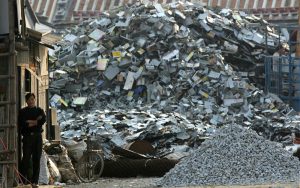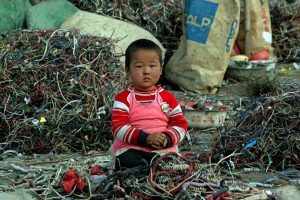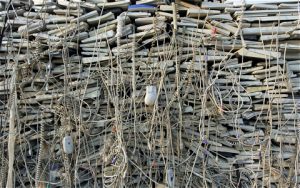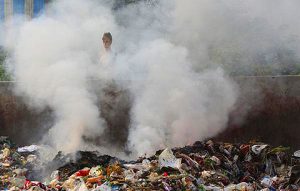The average European uses 16 tonnes of materials a year, such as paper, plastics, glass, and metals, but only 40% of this is recycled or reused. The rest is incinerated or, worse still, dumped in landfill.
This ‘take, make, use and throw away’ approach has helped enrich Europe’s economy over the last few decades.
But the global environment, not just the EU’s, is paying a heavy price, particularly because of the world’s seemingly insatiable demand for electrical and electronic goods.
These include fridges and washing machines, which use large amounts of steel, copper and chemicals; and plastic-coated products, which covers most audio and visual items as well as portable devices, such as laptops and mobile phones.
Many electrical items also use rare metals and minerals that are often harmful to extract and dispose of.
Consumption levels of consumer goods are now three times higher than they were 30 years ago, and the EU has to import eight times more materials and natural resources than it exports.
For electrical and electronic appliances the issue is more about mismanagement, pollution and human safety, with two thirds of white goods and electronic products processed illegally in countries such as Africa and China.
Almost 20% of global greenhouse gas emissions (GHGs) come from raw material production, plus another 3% from waste management.
It doesn’t help that only 40% of solid waste (defined as the useless and unwanted products in the solid state derived from the activities of and discarded by society) is currently recycled in the EU.
For plastics – perhaps the most-emblematic material for the world’s increasingly convenience-driven lifestyles – the figure is even lower (25%).
This seemingly carefree approach is not only taking a heavy toll on the environment, it is costing businesses and taxpayers money. On average, consultants at McKinsey noted, Europe uses materials only once.
"Our planet and our economy cannot survive if we continue with the 'take, make, use and throw away' approach,” said Frans Timmermans, the European Commission (EC) vice-president. “We need to retain precious resources and fully exploit all the economic value within them.”
Timmermans is the man tasked with turning Europe’s ‘linear’ (i.e wasteful) economy into a ‘circular’ one – where products are designed to last longer, use less energy and, at the end of their life, can be readily re-used or recycled.
This ecodesign approach helps develop products with special consideration for the environmental impacts during their whole lifecycle (usually divided into procurement, manufacture, use, and disposal).
Revising the EU’s rules so that products do less harm to the environment and use less energy remains a huge task in terms of implementation, and will have to deal with longstanding problems such as obstruction from some industry lobbies and hostility from Eurosceptic politicians.
Europe’s new ecodesign rules are deemed so politically sensitive that the EC was reported to have postponed further discussion of the proposals until after a referendum on the UK’s EU membership in June.
Those pushing for a so-called ‘Brexit’ complain that EU meddling has already made vacuum cleaners less powerful. NGOs and some parts of industry acknowledge that these complaints are often based on conjecture and inaccurate media reports rather than hard evidence.
Timmermans has already binned the original circular economy proposals agreed by his predecessors in 2014 and has aimed at a package that he feels member states and industry can actually deliver.
Indeed, he defended the revised proposals as “realistic rather than pie-in-the-sky”, but NGOs feel it has been watered down too much. The municipal waste recycling target, for instance, is now 65% rather than 70%, whilst a food waste reduction target has been scrapped altogether.
In terms of tracking e-waste and eco-design, there are few details in the draft. “We’re still a little sceptical [about the plans],” said Ferran Rosa, policy expert at Zero Waste Europe, a pressure group.
Nevertheless, through the proposals the EC aims to deliver big savings in energy and reduce the need for its waste to be buried, burned or shipped abroad.
Greenhouse gas emissions could be halved by 2030 and consumption of primary materials – including non-renewable fuels, pesticides and land – could drop by 32% in a circular economy, the EC estimates.
The EC also hopes the reforms will create three million new jobs across the bloc, and deliver net savings of €600 billion.
Built to last?
There is much work to be done, however. Helga Vanthournout, a senior expert at McKinsey’s Centre for Business and the Environment in Switzerland, cites relatively simple products that can take up to six minutes to dismantle in a “tear down” exercise.
“That’s a lifetime for a low-cost product in a high-cost labour market like the EU,” she said.
“What’s more, the valuable parts [only] came out in minutes five and six [of being dismantled],” a finding that highlights the need for products to be designed so components can be recycled and reused more easily.
The biggest shift, though, will be the requirement to design products so that they last much longer – an area where there has been “far too little emphasis” to date, according to Mark Hilton, a resources consultant with Eunomia.
Some researchers say manufacturers are building obsolescence into their products. Consumers that opt for a £5 (45.5 yuan) toaster perhaps won’t expect it to last, but how about a fridge freezer or a washing machine?
In some categories, consumer demand for fast-evolving technologies is the main cause of products being discarded.
Smartphones, for example, amount to “a periodic table in your pocket”, but tens of millions of these items are replaced in the EU each year; and despite cash incentives from manufacturers and operators for recycling and safe disposal, some old mobile phones aren’t dealt with an environmentally friendly manner.
Mobile phones contain silicon, tin, copper, lithium and silver, all of which require environmentally harmful mining and processing, as well a number of rare earth elements – most of which can only be found in China, where mining and processing of the materials comes at a heavy environmental cost.
A European consumer might not want to hang on to a ‘dated’ model, but if it’s built to last there’s a booming market for it overseas, says Eunomia’s Hilton. “An iPhone 4 may no longer be attractive [here in Europe] but it goes down really well in a developing country.”
Europe is considering whether a lifespan label on products will help. Manufacturers, generally, are strongly opposed to such a measure. The testing can be arduous, although some producers of white goods have already made extended warranties of up to 10 years available.
The EU’s proposal to revise its Ecodesign Directive (which dates back to 2009) would widen regulation beyond energy efficiency to the extent that products are more easily repaired and more durable.
Better quality?
In Asia where eco-design and energy efficiency standards can vary widely, manufacturers may be more co-operative than before.
Some experts believe suppliers are increasingly willing to raise quality as consumers in their own markets become more demanding and standards are tightened in Europe, a huge export market.
Natural resources used by manufacturers will also come under the microscope. Extraction of scarce ones embedded in products will need to made easier, cheaper and more effective, so they can be reused.
If Europe’s plan works then its use of primary materials could fall by a third by 2030, according to McKinsey.
There will also be substitutions of materials, but Jocelyn Blériot, policy lead at the Ellen MacArthur Foundation, a charity that promotes greener design and consumption, said “it’s far too early to say which ones are doomed”.
Marine pollution
Plastics are unlikely to be one of them given that they are oft-cited as the “workhorse” of the EU economy. The EC, clearly not impressed that recycling rates for plastic packaging have barely reached 25%, will unveil a new plastics strategy by 2017.
Once again, the idea will be to keep resources in use and in the EU for longer. Currently, a huge amount of wasted and discarded materials is escaping into the environment – by 2050, for example, there could be more plastic in the sea, by weight, than fish, estimates a report by the Ellen MacArthur Foundation
A recent study in the UK calculated that up to 53 billion small plastic pellets (used to process the majority of plastic products) could be escaping into the sea, where they suck up chemicals and are then mistakenly eaten by fish.
These pellets are hard to see but there is also plenty of other ‘macro’ litter, washing up on coastlines the world over too. This is a frequent, timely and toxic reminder of an era of careless consumption and irresponsible resource management. But we will have to wait before we can judge whether Europe’s new proposals can help turn the tide.







